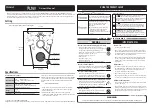
Command reference
R&S
®
ZNL/ZNLE
816
User Manual 1178.5966.02 ─ 19
Parameters:
<LayoutId>
Integer value 1, 2 ...
Current number, as defined by
Example:
See
Manual operation:
See
"Additional Functionality: SCPI Commands"
DISPlay:LAYout:DEFine
<LayoutId>, <LayoutFormatMode>, <LayoutData>
DISPlay:LAYout:DEFine?
<LayoutId>
Creates a horizontal or vertical display layout and provides it with an identifier (<Layou-
tId>).
Layouts are defined row by row (horizontal layouts) or column by column (vertical lay-
outs).
●
A horizontal layout consists of N rows, each of height h
i
(i = 1 to N). The heights
are defined in units relative to the total height of the screen, i.e. their sum h
1
+ h
2
+ ... h
N
must be equal to 1.00.
Each row contains a selectable number of diagrams with independent widths w
ij
(j
= 1, 2 ...M(i)). The sum of the widths in each row must also match the screen width,
hence w
i1
+ w
i2
+ ... w
iM(i)
= 1.00 for all rows (i = 1 to N).
The <LayoutData> string for horizontal layouts reads 'h
1
,w
11
,w
12
...
w
1M(1)
;h
2
,w
12
,w
22
... w
2M(2)
; ... ;h
N
, w
N1
,w
N2
... w
NM(N)
'.
A semicolon separates different rows, a comma separates different diagram widths
within a row.
●
The definition of a vertical layout is analogous, however, the role of rows and col-
umns is interchanged.
The query returns the layout data in an alternative, executable format. The executable
format is also used by
.
Use
cated (nested) layouts.
Note:
The maximum number of diagrams in a layout is 256.
Parameters:
<LayoutFormatMode>HORizontal | VERTical
Horizontal or vertical layout; see above.
<LayoutData>
String parameter defining the number of diagrams and their
position (easy format); see above.
Parameters for setting and query:
<LayoutId>
Integer value 1, 2 ...
Current number, used by other
DISPlay:LAYout...
com-
mands to reference the created layout.
Example:
See
Manual operation:
See
"Additional Functionality: SCPI Commands"
VNA command reference
















































